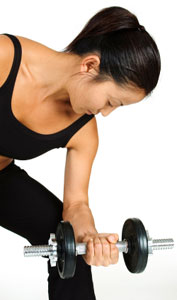 Every exercise routine needs to have a steady balance between strength training, endurance training, and cardiovascular training. Today’s topic, strength training, plays a huge roll in this equation. Strength training has been proven to increase bone density, increase lean muscle mass, improve posture, and reduce the risk of injury. The increase of bone density refers to the strengthening of the bones which helps prevent injury, pain, and arthritis. The increase of lean muscle mass increases the metabolism which allows the body to burn more calories each day and night.
Every exercise routine needs to have a steady balance between strength training, endurance training, and cardiovascular training. Today’s topic, strength training, plays a huge roll in this equation. Strength training has been proven to increase bone density, increase lean muscle mass, improve posture, and reduce the risk of injury. The increase of bone density refers to the strengthening of the bones which helps prevent injury, pain, and arthritis. The increase of lean muscle mass increases the metabolism which allows the body to burn more calories each day and night.
Common questions related to strength training include “How much weight should I use?” and “How many sets and repetitions should I do?”. Let me first say that every “body” is different and will react differently to the situation. Some people may pack on the muscle while others struggle to gain only a little bit. Strength training is a little more advanced than just simple weight training. Proper form and technique is a must and possible injuries could arise if each and every exercise is not performed correctly. Personal trainers or other fitness enthusiasts are typically available if you have questions about your form.
Beginner Guide to Strength Training:
- Warm up with a few body weight exercises such as push-ups, pull-ups, and crunches.
- Find a managable routine that breaks the muscle parts down each day (Monday-Chest/Back/Abs, Tuesday-Biceps/Triceps/Abs, Wednesday-Legs/Shoulders/Abs, and so on).
- Set aside NO MORE than an hour a day for at least four to five days a week.
- Start with three sets of 10 repetitions and gradually add weight to each set (Set 1: 25 lbs, Set 2: 35 lbs, Set 3: 45 lbs).
- After a few weeks, begin adding more sets and less repetitions (Week 1: 3 sets of 10 repetitions / Week 5: 4 sets of 8 repetitions / Week 9: 5 sets of 5 repetitions).
- Rest at least 30 to 90 seconds between each set to allow for muscle recovery.
- Doesn’t hurt to have a spotter or supervisor.
- Cool down with proper stretching or a few more body weight exercises.

